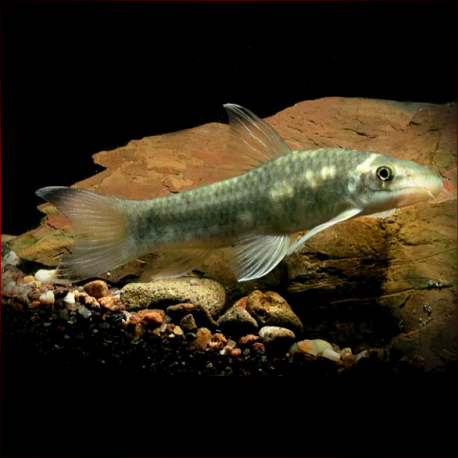More info
Datasheet
| Maximum Size | 6.0cm / 2.36inches |
General Description
Garra Rakhinica is distinguished by specific morphological characteristics such as a shallow rostral furrow, two pairs of barbels, and a nearly uniform greyish coloration with distinct markings on various fins. The genus Garra, to which it belongs, is a complex group with ongoing taxonomic revisions and a wide distribution spanning from southern China to parts of Africa.
Aquarium Setup
The aquarium setup for Garra Rakhinica should mimic its natural habitat in a forest river, with clear, still or slow-flowing water and a substrate of gravel, pebbles, and rocks. It is important to provide ample hiding spots and spaces for exploration. For specific requirements, refer to the table.
Behaviour
Garra Rakhinica, like other Garra species, possesses a modified lower lip forming a disc for clinging to surfaces in turbulent conditions. They are known to scrape food off the substrate using their keratinized jaw margins. Some species within the genus exhibit specialized adaptations, such as reduced eyes in cave-dwelling forms and tolerance to extreme environments like thermal springs.
Feeding and Diet
Being bottom-dwellers, Garra Rakhinica forages for food on the substrate. Their diet primarily consists of algae, small invertebrates, and organic debris. In an aquarium setup, they can be fed a varied diet including sinking pellets, algae wafers, and live or frozen foods like bloodworms and brine shrimp.
Reproduction & Dimorphism
Information specific to the reproduction and dimorphism of Garra Rakhinica is scarce. As with many cyprinids, they likely exhibit typical egg-scattering spawning behavior, potentially influenced by environmental cues. Sexual dimorphism, if present, may include subtle differences in body size or fin morphology.
Habitat and Distribution
Garra Rakhinica is endemic to a minor stream in western Myanmar, specifically the Rakhine Yoma mountain range. It inhabits forest rivers with clear water and a rocky substrate alongside various sympatric fish species like Devario xyrops and Xenentodon cancila. This species is known to occur in limited geographical locations as per its distribution data.

